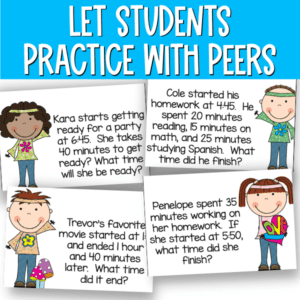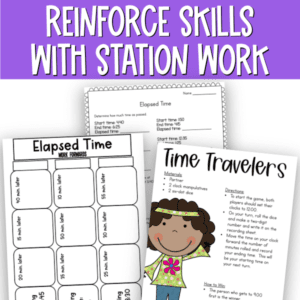Teaching elapsed time takes time, but once students get it they will use it forever. This is definitely a skill that applies to real life. For 3rd-graders, making elapsed time tangible and relatable is the key to success. In this blog post, I’m sharing my favorite classroom-tested ideas for teaching elapsed time by working forward. From using model clocks to converting clock time to a number line, these strategies will help your students become terrific timekeepers and make teaching elapsed time a breeze!
Begin teaching elapsed time working forward by introducing a large model clock to your students. Use this tangible tool to demonstrate how to calculate elapsed time by moving forward in increments. Start by showing how to advance by hours, then half-hours, and finally, by intervals of 5 minutes until you reach the new time. This hands-on approach provides a concrete representation of time’s progression. If you have access to small individual clock manipulatives, let your students move the hands along with you.
Encourage students to think of time as a journey, moving steadily from a starting point to an ending point. This metaphor helps solidify the concept of elapsed time in their minds.
For students who may struggle with the circular representation of a clock, demonstrate how to view the clock line as a stretched-out number line. Use the hours as “whole numbers” and the minutes as intervals between these whole numbers.

The next step is to give students some opportunity to practice with classmates in a no-pressure and interactive environment. I use this set of elapsed time cards. Igive each group of 3-5 students a set of cards to place face-down in the middle of the group. Taking turns as the leader, each student will draw and read a card. All members of the group will solve the amount of time that has elapsed. Once the leader sees that all members of the group have an answer, he/she will give a signal and all members of the group will compare answers, and discuss their answers.

Practice makes progress, so after we’ve had time to practice together and the students have gained confidence, we break into small groups and rotate through math station work time.
I like to use these elapsed time accordions. I have students cut out each accordion piece and fold in zig-zags to make an accordion with the ”starting time” on the front. On the inside squares, students solve the new time as the given number of minutes that have passed.
The game we play to practice elapsed time working forward is called Time Travelers. I pair students up and give each pair a game board and a recording sheet for each player in the group. I also remind them of my expectations for math games. You can download your own copy of these math games behavior expectations.
Materials:
Directions:
How to Win:
Use your textbook assignment or the worksheet in this lesson to give students a chance to show you what they’ve learned about finding elapsed time working forward and provide you with a quick assessment of their understanding.
You can grab all these activities in this lesson on elapsed time working forward in my TPT store or grab the whole time unit on TPT or in my webstore. Happy teaching!